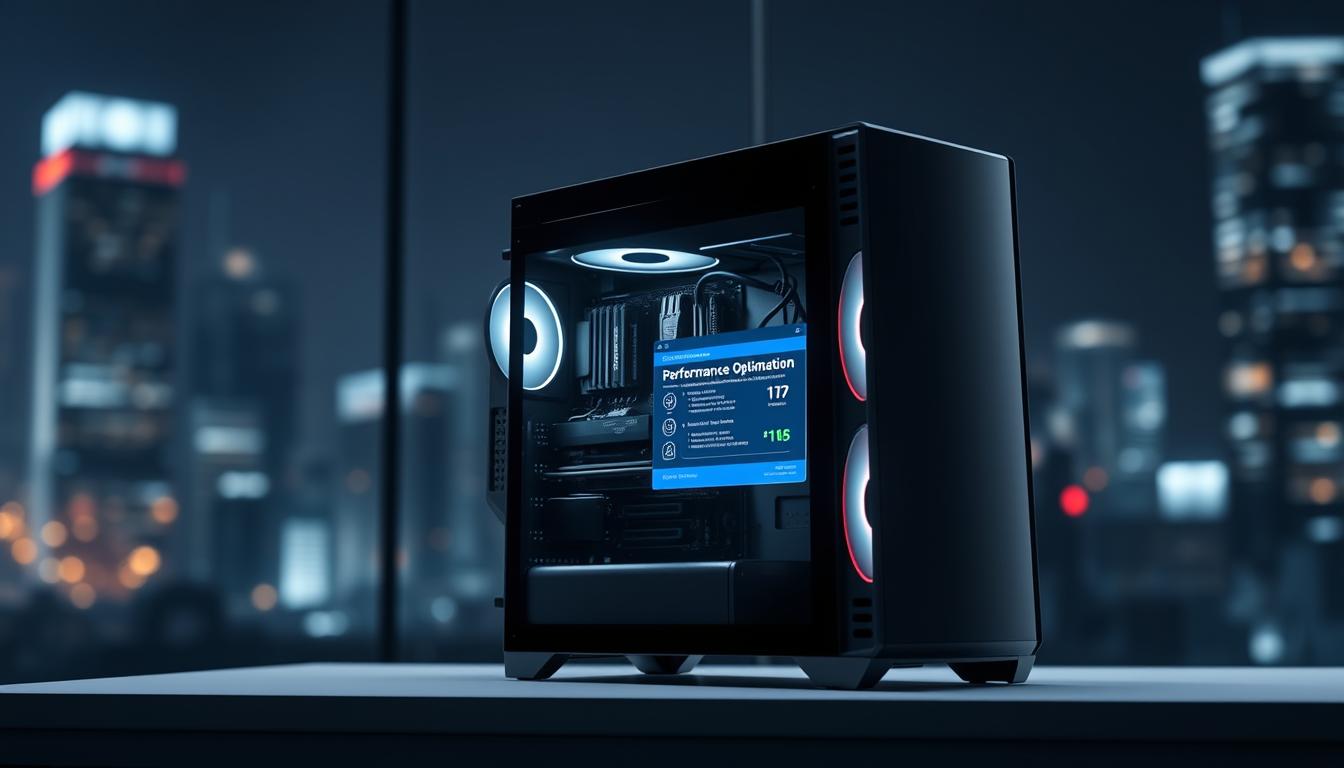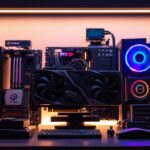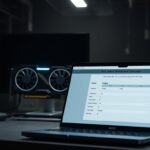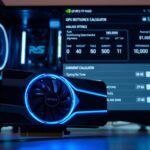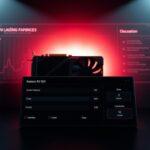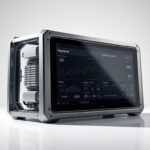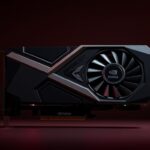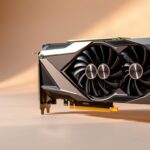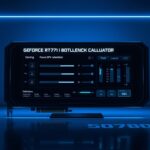Last Updated on August 7, 2025 by Gill
Ever felt frustrated with your computer’s slow performance? You’re not alone. Many users see a big drop in their PC’s efficiency over time. This is often because of bottlenecks. These bottlenecks can result from outdated hardware, insufficient memory, or even software conflicts. This is particularly frustrating for gamers, as performance issues in gaming PCs can significantly impact the overall experience. Regular maintenance and upgrades can help mitigate these problems and restore your system’s speed.
But, you don’t have to upgrade your hardware to improve pc performance. Making a few simple changes can make a big difference. In this article, we’ll look at common pc performance bottleneck causes. We’ll also share practical tips to fix them.
By the end of this guide, you’ll know how to fix pc bottleneck issues. You’ll enjoy a smoother computing experience.
Understanding PC Performance Bottlenecks
PC performance bottlenecks can really slow you down. But knowing what causes them is the first step to fixing them. To troubleshoot PC bottleneck issues, it’s key to understand the causes and how to solve them without buying new parts.
What Causes a PC Bottleneck?
A PC bottleneck happens when one part of your system holds back others. This can be due to old hardware, different speeds in components, or software that uses too many resources. Often, it’s because of an old CPU, not enough RAM, or slow storage. In many cases, addressing a PC bottleneck can lead to significant improvements in overall performance. For example, a ram bottleneck explained in 2025 could reveal how insufficient memory can limit multitasking and slow down applications. Upgrading components systematically can help users achieve a balanced configuration for optimal performance.
Types of Common PC Bottlenecks
There are a few main types of bottlenecks that can slow down your PC. These include:
- CPU bottlenecks, where the processor can’t handle tasks well
- RAM bottlenecks, where not enough memory slows down data processing
- Storage bottlenecks, where slow disks make accessing data hard
- GPU bottlenecks, where the graphics card is too slow or too fast
Why Software Solutions Matter
While getting new hardware can help, software tweaks can also make a big difference. By optimizing your operating system, apps, and settings, you can speed up your computer and lessen bottlenecks. Good software optimization can help you get the most out of what you already have.
Identifying Your Specific PC Performance Bottleneck
To boost your PC’s speed, you must find and fix its main slowdowns. Knowing what’s holding your computer back is key.
Using Windows Task Manager
Windows Task Manager is a great tool for checking your PC’s health. It shows how much CPU, RAM, and disk space your apps use. In addition to tracking resource usage, Windows Task Manager can help identify any applications that may be consuming excessive resources, allowing you to optimize performance. For users interested in ensuring their system runs smoothly, knowing how to monitor CPU temperature is essential, as overheating can lead to hardware issues and performance throttling. By keeping an eye on temperature levels, you can prevent potential damage and enhance your PC’s longevity.
Reading CPU, RAM, and Disk Usage
To open Task Manager, press Ctrl + Shift + Esc. The Performance tab shows graphs for CPU, memory, disk, and network. Look for high usage to spot bottlenecks.
Identifying Resource-Hungry Applications
In the Processes tab, you can see which apps use the most resources. Sorting by CPU, memory, or disk helps find the main slowdowns.
Specialized Diagnostic Tools
For a deeper look, use specialized tools. They give more detailed insights into your PC’s performance.
Free Performance Monitoring Software
Tools like CPU-Z and GPU-Z give detailed hardware info. Process Explorer offers advanced process management. Additionally, software such as HWMonitor provides comprehensive system health information, including realtime cpu temperature monitoring. This can be crucial for users who need to maintain optimal operating conditions for their hardware. Monitoring tools help in diagnosing potential overheating issues before they lead to hardware failure. Additionally, HWMonitor provides real-time monitoring of system temperatures, voltages, and fan speeds, making it easier to keep track of your hardware’s health. For gamers looking to optimize their performance, using these tools can also help check cpu temperature while gaming to ensure the system remains stable under heavy loads. By maintaining optimal temperatures, users can prevent thermal throttling and enhance their overall gaming experience.
Common Symptoms of Different Bottlenecks
Each bottleneck shows up in different ways. A CPU bottleneck might slow app loading. A RAM bottleneck could cause freezing.
| Bottleneck | Symptoms |
|---|---|
| CPU | Slow application loading, delayed task completion |
| RAM | Frequent freezing, inability to run multiple applications |
| Disk | Long loading times, slow file access |
Optimizing CPU Performance Without Hardware Upgrades
You can make your PC run faster by tweaking the CPU without buying new parts. This means using software to make your computer work better.
Managing Background Processes
One key step is to manage what’s running in the background. This means stopping programs you don’t need and closing tasks that use a lot of resources.
Disabling Unnecessary Startup Programs
Many programs start automatically when you turn on your PC. Turning these off can make your PC start up faster and run better. To do this, open the Task Manager, go to the Startup tab, and turn off programs you don’t use.
Ending Resource-Intensive Background Tasks
Some apps keep running in the background and use up CPU power. Use the Task Manager to find and stop these tasks. This frees up CPU power for more important things.
Adjusting Power Plans for Maximum Performance
Windows has different power plans that can change how your PC performs. Switching to the “High Performance” or “Ultimate Performance” plan lets your CPU work harder. This can improve PC performance.
Process Priority Optimization
Changing the priority of processes in the Task Manager can also help. Setting some apps to “High” or “Realtime” priority means they get more CPU power.
CPU-Intensive Application Settings
Many apps have settings to lower CPU usage. For example, reducing graphics in games can make your PC run better and use less CPU.
By using these tips, you can make your PC run faster without buying new hardware.
Maximizing RAM Efficiency
One of the best ways to make your PC faster is to improve RAM efficiency. This means using memory management, optimizing virtual memory, and cutting down RAM use in Windows.
Memory Management Techniques
Good memory management boosts PC speed. Two easy ways are closing unused apps and choosing lightweight software.
Closing Unused Applications
Shutting down unused apps frees up RAM. This makes your PC run better. Open Task Manager, find apps using lots of resources, and close them.
Using Lightweight Alternatives
Lightweight software can cut down RAM use. For example, switching to a less heavy browser like Microsoft Edge or Opera can help.
Virtual Memory Optimization
Optimizing virtual memory is also key. Adjusting pagefile settings can improve your computer’s speed.
Configuring Pagefile Settings
To tweak pagefile settings, go to System Properties, then Performance Options. Adjust the virtual memory settings there. A custom size can boost performance.
| Action | Benefit |
|---|---|
| Close unused applications | Frees up RAM |
| Use lightweight software | Reduces RAM usage |
| Configure pagefile settings | Optimizes virtual memory |
Reducing RAM Usage in Windows
To lower RAM use in Windows, turn off startup programs you don’t need. Also, use 64-bit apps when you can.
Browser Memory Management
Managing browser memory is important. Clearing browser cache, disabling extensions you don’t need, and using browser task managers can fix slow PC problems.
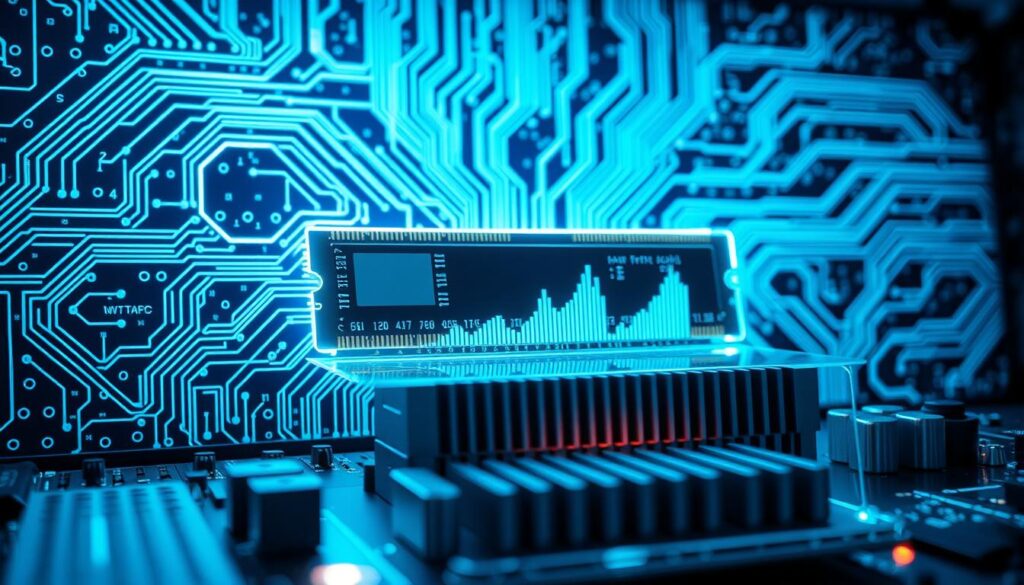
By using these tips, you can greatly improve your PC’s speed and efficiency. This will make your computing experience better.
How to Fix PC Bottleneck Issues Related to Storage
PC bottlenecks related to storage can be frustrating. But, there are ways to fix these issues without upgrading hardware. Slow loading times and delayed file access are common problems. To solve these, you need to clean up disk space, defragment, and optimize storage.
Disk Cleanup and Defragmentation
Disk cleanup and defragmentation are key to better storage performance. Disk cleanup removes unnecessary files that take up space. Defragmentation makes data easier to access.
Running Built-in Windows Tools
Windows has tools for disk cleanup and defragmentation. You can find Disk Cleanup in the Start menu. Optimize Drives handles defragmentation. Using these tools regularly keeps your storage running smoothly.
Third-Party Optimization Software
Third-party software offers more features for disk cleanup and defragmentation. CCleaner and Defraggler give you more control over optimization.
Storage Partitioning Strategies
Storage partitioning divides a hard drive into sections. This helps organize data and boost performance. By separating data from programs, you reduce fragmentation and improve efficiency.
File System Optimization
Keeping the file system healthy is key to storage performance. Tools like CheckDisk can fix errors. Optimizing the file system for your data also helps.
SSD Maintenance Without Replacement
SSD maintenance is different from traditional hard drives. Enabling TRIM commands keeps SSDs running well. Regular firmware updates also ensure top performance.
TRIM Commands and Firmware Updates
To enable TRIM commands on Windows, use the Command Prompt. Run the command: fsutil behavior set disabledeletenotify 0. Check for firmware updates through the SSD manufacturer’s software to keep your SSD in top shape.
Enhancing GPU Performance Through Software
Boosting GPU performance is key to improving PC performance. You can do this through software tweaks. While upgrading hardware is common, software changes can also make a big difference. Optimizing your settings can lead to smoother frame rates and better overall responsiveness during gameplay. Additionally, understanding gaming performance issues explained can help identify specific bottlenecks in your system, allowing you to implement targeted solutions that enhance your experience. Moreover, regular updates to both drivers and software can unlock hidden potential in your GPU, ensuring you get the most out of your gaming rig.
Graphics Driver Optimization
Optimizing graphics drivers is a top way to boost PC speed. Old or wrong drivers can slow down your GPU.
Finding and Installing the Right Drivers
To get your GPU running well, use the right drivers. First, find out what GPU you have. Then, look for the latest drivers on the manufacturer’s site or through their software.
Driver Settings Configuration
After getting the right drivers, tweak their settings. Adjust texture filtering, anti-aliasing, and other graphics options. This balances performance and quality.
Game and Application Settings
Changing game and app settings is also important for GPU optimization. Tweaking these settings can make your experience smoother without losing quality.
Reducing Graphical Demands
Lowering some graphics settings, like shadow quality, can boost performance. It’s about finding the right mix of quality and speed.
Resolution and Quality Adjustments
Changing resolution and quality settings in apps can also affect GPU performance. Lowering these can make things run smoother.
GPU Scheduling and Prioritization
Managing how your GPU uses resources is key. By focusing on important tasks, you make sure your GPU works efficiently.
Safe Software-Based GPU Optimization
When optimizing your GPU, be careful. Stay away from untested software that promises too much. Use only trusted software and methods from hardware makers. Research the latest gpu performance optimization techniques recommended by industry experts, as they can provide valuable insights and proven strategies. Additionally, regularly update your GPU drivers to ensure compatibility and maximize performance benefits from newly released updates. Remember that proper cooling and power management also play critical roles in maintaining optimal performance levels during intensive tasks.
With these software tweaks, you can greatly enhance computer performance. Your computing will be smoother and more efficient.
Resolving Network and Internet Bottlenecks
To fix slow PC issues, you need to tweak your network and internet settings. Network bottlenecks can slow down your online activities. This can make you frustrated and less productive.
Network Settings Optimization
Improving your network settings is key to solving internet bottlenecks. You should adjust settings to speed up data transfer and cut down on delays.
DNS Configuration
Choosing a reliable DNS service can boost your internet speed. If your current DNS is slow, think about switching to a faster one.
TCP/IP Settings Adjustment
Changing your TCP/IP settings can also enhance network performance. This means tweaking settings to lower delays and boost data transfer.
Browser and Download Management
Managing your browser extensions and downloads can help too. Turn off unused extensions and limit how many things you download at once. This can make your browsing faster.
Quality of Service (QoS) Configuration
Setting up QoS lets you focus on important apps. This ensures they get enough bandwidth, even when it’s busy.
Wi-Fi Signal Optimization
Improving your Wi-Fi signal can greatly enhance your network. Try moving your router, updating its software, and cutting down on interference from other devices.
By using these methods, you can tackle network and internet bottlenecks. This will make your computer run faster and more smoothly.
| Optimization Technique | Description | Benefit |
|---|---|---|
| DNS Configuration | Switch to a faster DNS provider | Enhanced internet speed |
| TCP/IP Settings | Adjust settings for optimal performance | Reduced latency |
| QoS Configuration | Prioritize critical applications | Ensured bandwidth for important tasks |
Software Optimization Techniques for Better Performance
To make your PC faster, using software optimization is key. These methods boost your computer’s speed and efficiency. You don’t need to buy new hardware.
Operating System Tweaks
Optimizing your operating system is a great way to speed up your PC. You can make tweaks to make your system run smoother.
Disabling Visual Effects
Turning off visual effects saves system resources. In Windows, go to System Properties, then Performance Options. Choose “Adjust for best performance.”
Services Optimization
Optimizing services means stopping services you don’t need. Use the Services console (services.msc) to find and stop unnecessary services.
Application-Specific Optimizations
Many apps can run faster with some tweaks. Keeping your software up to date is a good start. Updates often make apps run better.
For example, tweaking your web browser can help. Try disabling extensions and plugins you don’t use. This makes your browser faster.
Lightweight Alternatives to Resource-Heavy Software
Switching to lighter software can make a big difference. Instead of Adobe Photoshop, try GIMP or Paint.NET. They’re faster and use less resources.
| Resource-Heavy Software | Lightweight Alternatives |
|---|---|
| Adobe Photoshop | GIMP, Paint.NET |
| Microsoft Office | LibreOffice |
Registry Cleaning and Maintenance
Registry cleaning removes old entries that slow you down. Tools like CCleaner help keep your registry clean.
“Regular registry cleaning can help maintain your PC’s performance over time.” –
By using these software tweaks, you can make your computer run better. It will last longer too.
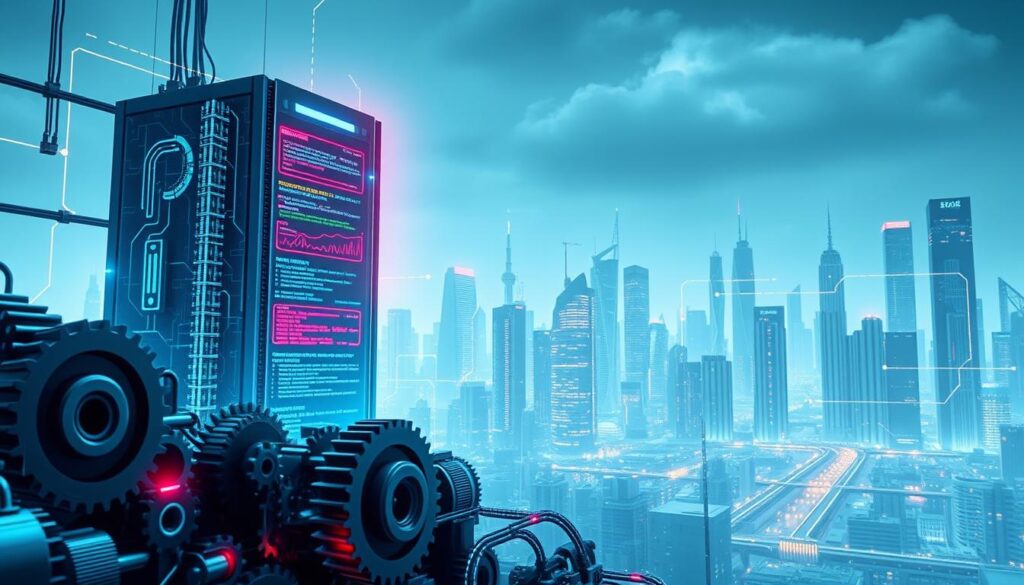
System Maintenance Practices to Prevent Bottlenecks
To stop bottlenecks in your PC, you need to be proactive with maintenance. Regular upkeep keeps your computer running well and boosts its speed.
Creating a Regular Maintenance Schedule
It’s key to have a set maintenance plan for your PC. This plan should include:
- Daily: Check for updates and do quick virus scans.
- Weekly: Clean up disk space and defragment.
- Monthly: Do deep virus scans and update drivers.
Daily, Weekly, and Monthly Tasks
Divide maintenance into daily, weekly, and monthly tasks. This makes keeping your PC healthy easier.
Automated Maintenance Tools
Automated tools make maintenance easier. CCleaner for disk cleanup and Malwarebytes for malware detection can run on their own.
Thermal Management and Cooling
Good thermal management stops overheating. Overheating can slow down your PC.
Dust Removal and Airflow Optimization
Cleaning dust from vents and fans improves airflow. This helps avoid overheating.
Software-Based Fan Control
| Maintenance Task | Frequency | Benefit |
|---|---|---|
| Disk Cleanup | Weekly | Frees up disk space |
| Virus Scan | Monthly | Ensures system security |
| Driver Updates | Monthly | Improves system stability |
By following these maintenance steps, you can make your computer faster. This helps speed up your computer and resolve slow PC issues, keeping it running smoothly.
When Software Solutions Aren’t Enough: Setting Realistic Expectations
Software optimizations can boost PC performance, but they have limits. Knowing these limits is key to fixing PC bottlenecks and improving computer speed. Identifying the precise points where performance is stifled allows users to effectively target their upgrades. Utilizing tools with bottleneck calculator functionality can further assist in diagnosing specific hardware constraints. By understanding these factors, users can make informed decisions that lead to a noticeable enhancement in their system’s efficiency.
Understanding Hardware Limitations
Components like CPU, RAM, and GPU have limits that software can’t change. For example, an old CPU can’t handle tough tasks as well as a new one, no matter the software.
Prioritizing Tasks Based on Your System’s Capabilities
To boost PC speed, focus on tasks that fit your system’s abilities. This might mean:
- Using less demanding apps when doing important tasks
- Turning off unused background programs to save resources
- Not multitasking with heavy programs
Planning Strategic Hardware Upgrades
Sometimes, you need to upgrade hardware for better performance. This could be:
- Adding more RAM for running more apps at once
- Switching to a faster SSD from a traditional hard drive
Cloud-Based Alternatives for Processing-Heavy Tasks
For tasks too heavy for your computer, try cloud services. Cloud computing offers the power needed for tasks like video editing, 3D modeling, and complex data analysis.
By knowing hardware limits, focusing on tasks, upgrading strategically, and using cloud services, you can fix PC bottlenecks and make your computer faster.
Conclusion
Fixing common PC bottlenecks without upgrading hardware is possible. You can do this through software optimizations and maintenance. Understanding the causes and identifying specific issues helps users apply targeted solutions.
Improving CPU performance, maximizing RAM, and solving storage and network bottlenecks are key. Regular maintenance like disk cleanup, defragmentation, and thermal management also helps. These steps prevent bottlenecks and keep your PC running well.
Using software-based strategies can greatly improve your PC’s performance. Adjusting power plans, managing background processes, and optimizing graphics drivers are effective. These actions help increase your PC’s speed and efficiency.
- RTX 3070 Bottleneck Calculator: Optimize Your Setup - September 27, 2025
- Optimize Your RTX 3060 Ti: Use Our Bottleneck Calculator - September 26, 2025
- GeForce RTX 5060 Bottleneck Calculator – Find Your GPU’s Limits - September 25, 2025

